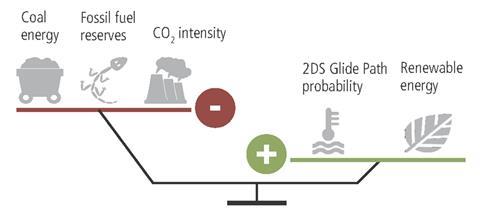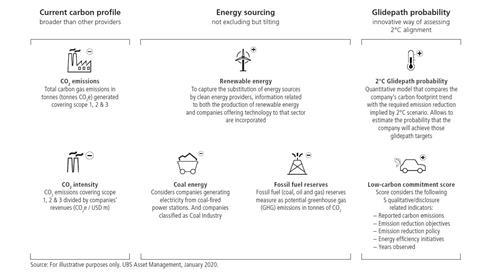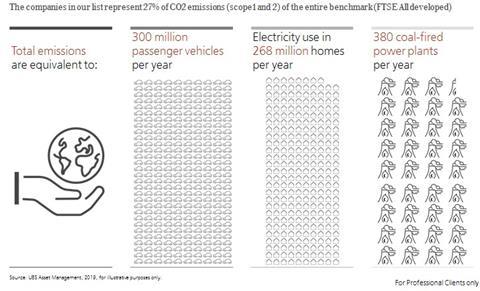- Signatory name: UBS Asset Management
- Signatory type: Investment manager
- Operating region: Global
- Assets under management: US$903 billion (31 December 2019)
- Assets in passive/index strategies: US$374 billion (31 December 2019)
UBS Asset Management has been managing index- and rules-based assets for over 35 years, with current index AUM of more than US$383 billion. More than two thirds of our index AUM have ESG components, including more than US$3 billion AUM in our award winning Climate Aware rules-based strategy.
Why create a new passive strategy?
In order to collaborate with our clients in addressing climate change risks for passive allocation, we designed a rules-based equity solution to capitalise on the long-term transition to a low greenhouse gas (GHG) emissions economy. The strategy needed to have the flexibility to increase or decrease exposures to constituents of the index based on their expected contributions towards climate change, while delivering returns broadly in line with traditional developed markets indexes (FTSE Developed and MSCI World).
We combined a multi-dimensional set of metrics seeking to keep returns aligned with a mainstream benchmark, while achieving climate change targets including: a) reducing exposure to coal energy, fossil fuel reserves and GHG growth and intensity, while b) increasing exposure to renewable energy and companies aligning their strategies with a low-carbon future.
How we created the passive, developed markets equity strategy
ESG incorporation model
The solution combines quantitative and qualitative information, in a systematic, rules-based approach. Within the risk budget available, the strategy redistributes about 15% of the total investment through a series of factor tilts (three risk-reducing and two opportunity-seeking): a negative tilt is used to reduce the size of the investment in companies with worse than average GHG emissions, companies using energy derived from coal and those with large reserves of fossil fuels; a positive tilt is used to increase exposure to companies providing renewable energy and supporting related technology, and those with a good probability of achieving a 2o C scenario glide path target. Seven data sets* are used to assess each company across the five factor tilts.
Figure 1: Factor tilts applied to the Climate Aware fund

The quantitative model compares the company’s carbon footprint trend with the required emission reduction implied by a 2ᵒC scenario defined by the International Energy Agency (IEA). To mitigate carbon data quality problems and reporting weaknesses, the estimates of the quantitative model are backed up by qualitative insights about companies’ disclosure through the Carbon Disclosure Project (CDP), as well as their implementation of policies, objectives and/or initiatives related to carbon efficiency.
Figure 2: Quantitative and qualitative factors

The final step is to feed each company’s scores across the five factor tilts into a portfolio optimiser alongside the portfolio’s existing investment constraints (e.g., sector, country, factor) – looking to maximise the low-carbon credentials in an efficient model portfolio, subject to meeting the pre-set constraints.
Stewardship programme
The passive strategy is combined with a focused stewardship programme, covering engagement (individual and collective) and proxy voting.
Engagement
Engagement allows us to share the results of the quantitative and qualitative assessments in the fund methodology with investee companies. It enables us to verify corporate performance against other data sources, and to think about enhancements to those sources, and to the model. Engaging directly with companies means we can explicitly communicate changes we want to see in corporate practices, and collect feedback.
When selecting engagement targets, the 50 companies with the largest underweights in the oil & gas and utilities sectors were considered, given that these sectors have the most significant impact on the climate footprint of the portfolio. We also considered assessment from our equity analysts of which companies were most likely to be receptive to engagement dialogue. The resulting focus list represents 27% of CO2 emissions (scope 1 and 2) of the entire benchmark (FTSE All developed).
Figure 3: Engagement program covered CO2 emissions

Between March 2018 and December 2019 we engaged with 100% of our focus list across more than 120 meetings, primarily with heads of sustainability and board members: 36% of companies have shown good progress against defined targets, 36% have met some of our requests and 28% have shown limited responsiveness. Engagement objectives may involve determining the right board composition to oversee climate risks, setting (and/or showing progress against) ambitious, long-term climate targets, conducting scenario analysis, assessing how consistent direct/indirect lobbying activities are with the company’s public position on climate change and whether they are disclosing information in line with the Task Force on Climate Disclosure (TCFD) recommendations.
Voting
Voting activities allow us to reinforce the messages communicated to management during engagement, and we will vote consistently to support climate resolutions that align with shareholder interests across all of our holdings in UBS AM. In the last proxy voting season, we supported 82% of shareholder resolutions focused on climate change. Having a vote also allows us to express dissent toward lagging companies by considering voting against the board chairman of a company if we have not seen sufficient progress on the topics raised during our climate change engagement programme.
Next steps
In order to further enhance the methodology, we are monitoring new additional sources of information on physical risks, patent data, supply chain efforts and qualitative assessments of climate governance, risk and targets. We are also considering alternative scenarios to define the glide path’s probability scores.
The engagement programme will last for three years and we are evaluating options to incorporate the results through further increases/decreases of exposure (within the established tracking error – 0.3% experienced so far, against 0.5% limit) and/or potential exclusions.
References
*Data sets 1-3 include: scope 1 CO2 emissions resulting from the company’s consumption of fossil fuels in its own production processes; scope 2 CO2 emissions representing the level of indirect emissions arising from the consumption of purchased power; and scope 3 emissions representing any indirect emissions associated with the company’s purchasing and sales activities not otherwise captured. Data set 4 comprises both the absolute level of coal-fired energy generated and the output of coal mining companies. Data set 5 includes fossil fuel reserves, while data set 6 includes investments in renewable energy and associated technologies. Importantly, the optimization process incorporates a Glide Path Probability score (data set 7) to account for the trajectory of CO2 reductions, and therefore the likelihood that each company is reducing emissions in line with a low carbon reduction scenario.












